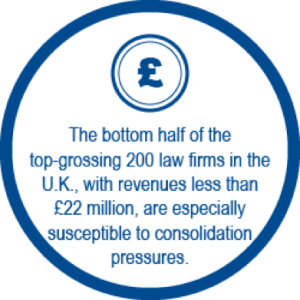Law firm merger mania
Exactly one year ago in January 2016 a report in Law360.com stated that the top 200 law firms in the U.K. could be reduced in number by as much as 75 percent over the next five years due to consolidation. The report was produced by Arden Partners, a London-based investment bank.
Arden Partners analyzed data released recently by legal publication The Lawyer detailing financial information on the top law firms in the U.K. and concluded that the nation’s legal sector is at a “tipping point,” with significant external investment driving rapid consolidation and funding new, disruptive law firms.
The legal sector is currently highly fragmented because external investors have historically had extremely limited opportunities to invest in the sector, the Arden Partners report said.
“As a result, partners have had no incentive to disrupt the status quo that has provided them with long term annuity streams,” it said.
In 2007, the U.K. government passed the Legal Services Act, which allows external investors to have majority control of companies, including law firms, and since 2012, firms have used the alternative business structure model, or ABS, to put the new law into practice.
“The UK legal services market is now going through far reaching but still not fully recognised change,” the report said. “A changing marketplace has resulted from an unparalleled period of change precipitated by the introduction of alternate business structures.”
Accounting firms in the U.K. led the way in terms of consolidation prompted by ABS investment, the report said, and that consolidation was quick and transformational. The same should be expected in the legal industry, it said.
“Over the next five years significant consolidation is expected and, if the accounting firms’ precedent is even broadly followed, the top 200 law firms may well be reduced by 75 per cent in number,” Arden predicted. “This will be especially noteworthy in the mid-market regional space where a number of firms are already positioning to be prime beneficiaries of the upheaval.”
That means as many as 70 firms currently on the top-200 list generated by The Lawyer could vanish over the next several years, with over £3 billion ($4.33 billion) of revenue changing control, the investment bank said.
It offered an example of the disruptive capability of outside investment: the entry of Australian law firm, Slater & Gordon into the U.K. market in 2012.
Slater & Gordon became the world’s first publicly traded law firm in 2007 and started its march into the U.K. a few years later, only to become one of the largest law firms in the U.K. by 2015 with revenue in the country reaching £352 million. The firm’s meteoric growth in the U.K. happened through nearly 40 acquisitions, according to Arden Partners. The boom in acquisitions was supported by the firm’s ability to access financing from external investors, the report said.
“From scratch this acquisition strategy has created a UK legal market leader in three years, encapsulating the pace of change that is coming to the sector,” Arden Partners said. So how did these predictions pan out for the year? Well on the 9th of January 2017 the ABA journal confirmed that it had indeed been a very busy year in law firm mergers and acquisitions with more than 80 law firm mergers or acquisitions. This is expected to intensify in 2017. So here are a few of the headline grabbers:
- Arnold & Porter and Kaye Scholer
- Eversheds and Sutherland
- Norton Rose Fulbright and Canadian firm Bull Housser
- Norton Rose Fulbright and Chadbourne & Parke
- Dentons tied up another deal with Munoz Global in Costa Rica
- DLA Piper completed deals in Canada, Finland and Sweden.
- Finally, the 3 way CMS/Nabarro/Olswang
What a year!


